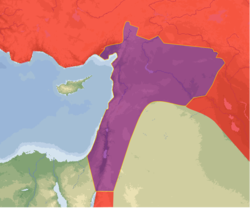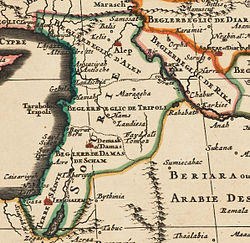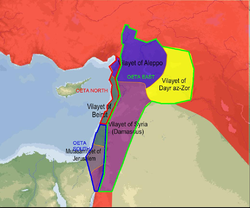- Ottoman Syria
-
Ottoman Syria
سورية في العصر العثمانيTerritory of the Ottoman Empire ← 
1516–1918  →
→
 →
→Flag
Territories included in Syrian provinces throughout the Ottoman era Capital Aleppo[1] Language(s) Ottoman Turkish, Syrian Arabic, Persian Political structure Territory of the Ottoman Empire History - Battle of Marj Dabiq August 24, 1516 - al-Ma'ni insurrection in the Eyalet of Damascus 1633 - Invasion by Muhammad Ali of Egypt 1831 - Mount Lebanon gains a special status 1861 - British occupation, French occupation 1918 Today part of  Iraq
Iraq
 Israel
Israel
 Jordan
Jordan
 Lebanon
Lebanon
 Palestinian Territories
Palestinian Territories
 Syria
Syria
 Turkey
TurkeyOttoman Syria is a European reference to the area that during European Renaissance from the late 15th to early 18th century was called the Levant within the early period of the Ottoman Empire[2], the Orient until the early 19th century, and Greater Syria until 1918. Territory of the Greater Syria under the Ottoman rule in its final historical period included modern Syria, Lebanon, Israel, the West Bank, Gaza Strip, Jordan, and parts of Turkey and Iraq.
Contents
History
See also: Timeline of Ottoman SyriaBefore 1516, historical or Greater Syria was part of the Mamluk Empire centered in Egypt. The Ottoman Sultan Selim I conquered Syria in 1516 after defeating the Mamlukes at the Battle of Marj Dabiq near Aleppo in northern Syria. Selim carried on his victorious campaign against the Mamlukes and conquered Egypt in 1517 following the Battle of Ridanieh, bringing an end to the Mamluk Sultanate.
Administrative divisions
See also: Subdivisions of the Ottoman EmpireWhen he first seized Syria in 1516, Selim I kept the administrative subdivisions of the Mamluk period unchanged. After he came back from Egypt in July 1517, he reorganized Syria into one large province or eyalet named Şam (Arabic/Turkish for "Syria"). The eyalet was subdivided into several districts or sanjaks.
1516
The Principality of Lebanon was awarded to Prince Fakhr al-Din I of the Maan dynasty after aiding the Sultan defeat the Mamluks at the Battle of Marj Dabiq. The principality consisted mainly of today's Lebanon with the exception of the cities of Tripoli and Saida. It was a Constitutional Monarchy ruled by a prince first from the Maan Dynasty followed by the Chihabs. The Principality remained as a semi-independent entity within the Ottoman Empire until 1860 when it was replaced by another semi-independent regime known as the Mutasarrifate.
1549
In 1549, Syria was reorganized into two eyalets. The northern Sanjak of Aleppo became the center of the new Eyalet of Aleppo. At this time, the two Syrian Eyalets were subdivided as follows:
- The Eyalet of Aleppo (Arabic: إيالة حلب)
- The Sanjak of Aleppo
- The Sanjak of Adana (أضنة)
- The Sanjak of Ablistan (Marash (مرعش))
- The Sanjak of Aintab (عينتاب)
- The Sanjak of Birejik (البيرة) (Urfa (أورفة))
- The Sanjak of Kilis (كلس)
- The Sanjak of Ma'arra (معرة النعمان)
- The Sanjak of Hama (حماة)
- The Sanjak of Salamiya (سلمية)
- The Sanjak of Homs (حمص)
- The Eyalet of Damascus (Arabic: إيالة العرب)
1579
In 1579, the Eyalet of Tripoli was established under the name of Tripoli of Syria (Turkish:Trablusşam) (Arabic: طرابلس الشام). At this time, the eyalets became as follows:
The Eyalet of Aleppo included the Sanjaks of Aleppo, Adana, Marash, Aintab, and Urfa.
The Eyalet of Tripoli included the Sanjaks of Tripoli, Latakia, Hama and Homs.
The Eyalet of Damascus included the Sanjaks of Damascus, Beirut, Sidon, Acre, Safad, Nablus, Jerusalem, Gaza, Hauran and Ma'an
1586
In 1586, the Eyalet of Raqqa was established in eastern Syria. It lasted until the Egyptian invasion in 1831 and included Eyalet of Raqqa (Arabic: إيالة الرقة), Sanjak of Urfa, Sanjak of Marash, Sanjak of Dayr Rahba, Sanjak of Khabour, Sanjak of Jamasa and Sanjak of Bani Rabi'a.
1660
The Eyalet of Safad was established in 1660. It was later renamed the Eyalet of Sidon, and later, the Eyalet of Beirut.
1861
Following the massacre of thousands of Christian civilians during the 1860 Lebanon conflict, and under a growing European pressure, mainly from France, an Ottoman edict issued in 1861 transformed "Al Kaimaqumyateen," the former regime based on religious rule that led to civil war, into the Mutesarrifiyyet governed by a Mutasarrıf who according to law had to be a non-Lebanese Christian .
1864
As part of the Tanzimat reforms, an Ottoman law passed in 1864 provided for a standard provincial administration throughout the empire with the Eyalets becoming smaller Vilayets governed by a Wali or governor still appointed by the Porte but with new provincial assemblies participating in administration.
1874
In 1874, Jerusalem became a Mutesarrifiyyet gaining a special administrative status.
1877
In 1877, the subdivisions of Syria were Aleppo Vilayet (Arabic: ولاية حلب), Deir ez-Zor Vilayet (Arabic: ولاية دير الزور), Beirut Vilayet (Arabic: ولاية بيروت), Damascus Vilayet (Arabic: ولاية سورية); Mutesarrifiyyet of Mount Lebanon (Arabic: متصرفية جبل لبنان); Mutesarrifiyyet of Jerusalem (Arabic: متصرفية القدس الشريف)
References
- Bayyat, Fadil The Ottoman State in the Arab Scope (Arabic, 2007)
See also
- History of Syria
- Roman Syria
- Sykes-Picot Agreement
- Arab Kingdom of Syria
- French Mandate of Syria
- Southern Syria
External Links
Ottoman History Podcast: History of Ottoman Syria
 Subdivisions of the Ottoman Empire
Subdivisions of the Ottoman EmpireEyalets (1363–1864) AfricaAnatoliaAdana · Aidin · Anatolia · Ankara · Archipelago · Diyarbekir · Dulkadir · Erzurum · Hüdavendigâr · Karaman · Karasi · Kars · Kastamonu · Rum · Trebizond · VanAsiaEuropeVilayets (1864–1922) AnatoliaAdana · Aidin · Ankara · Archipelago · Bitlis · Diyâr-ı Bekr · Erzurum · Hüdavendigâr · Istanbul · Kastamonu · Konya · Mamuret-ul-Aziz · Sivas · Trebizond · VanEuropeElsewhereVassals and autonomies Cossack Hetmanate · Cretan State · Crimean Khanate · Khedivate of Egypt · Principality of Moldavia · Sharifate of Mecca · Republic of Ragusa · Eastern Rumelia · Principality of Samos · Serbian Despotate · Duchy of Syrmia · Principality of Transylvania · Tunis Eyalet · Principality of WallachiaSee also the list of short-lived Ottoman provincesHistory of modern states under the Ottoman Empire Africa Asia Europe Albania · Bosnia and Herzegovina · Bulgaria · Greece · Hungary · Kosovo · Macedonia · Montenegro · Serbia Syria topics
Syria topicsHistory Ancient · Roman · Islamic · Ottoman · Arab Kingdom of Syria · French Mandate · Modern (2011 uprising)Government Arab Socialist Ba'ath Party (National Progressive Front) · Constitution · President · Vice President · Cabinet (Prime Minister, Ministries) · Parliament (Speaker) · Judiciary (Council, Supreme Court) · Military (Army, Air Force, Navy, Air Defense)Politics Geography Fertile Crescent · Greater Syria · Governorates · Districts · Cities · Southern Syria · Hauran · Golan Heights · Al-Jazira · Syrian Desert · Anti-Lebanon mountains · Hermon · Euphrates · Orontes · Rivers · VolcanoesInfrastructure Economy Society Culture Issues Categories:- Former countries in the Middle East
- States and territories established in 1516
- States and territories disestablished in 1918
- 1918 disestablishments
- Ottoman Syria
- The Eyalet of Aleppo (Arabic: إيالة حلب)
Wikimedia Foundation. 2010.





